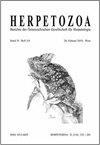Migration strategy of the Great crested newt (Triturus cristatus) in an artificial pond
IF 0.9
4区 生物学
Q3 ZOOLOGY
引用次数: 0
Abstract
In animals, migration is an evolutionary adaptation to manage seasonally varying habitats. Often driven by climatic changes or resource availability, amphibians then migrate from their hibernation sites to their breeding grounds. This research focused on the migratory habits of the Great crested newt (Triturus cristatus). The study explored factors like gender, body size, and environmental determinants, noting that immigration and emigration events proved distinct during the year. Results unveiled that males typically reached ponds first, with temperature being pivotal: males preferred up to 5 °C, females around 10 °C, while juveniles moved as temperatures increase. Wind velocity affected larger newts, around 120 mm, prompting them to migrate with stronger winds. Notably, heavy rainfall favored migration of newts of roughly 60 mm size. Humidity displayed gender-based trends: males associated positively with average levels, females showed aversion above 50%, and juveniles leaned towards drier conditions. Emigration patterns mirrored these findings, emphasizing roles of temperature, wind, and humidity. The effect of moonlight is not statistically significant. These findings provide valuable insights into the environmental factors influencing the migration of T. cristatus, which may guide future conservation efforts.人工池塘中大冠蝾螈的迁徙策略
在动物中,迁徙是一种进化适应,以管理季节性变化的栖息地。通常在气候变化或资源可用性的驱动下,两栖动物会从冬眠地迁徙到繁殖地。这项研究的重点是大冠蝾螈(Triturus cristatus)的迁徙习性。研究探讨了性别、体型和环境决定因素等因素,并注意到迁徙和迁出事件在一年中是截然不同的。研究结果表明,雄性蝾螈通常最先到达池塘,而温度是关键因素:雄性蝾螈喜欢温度在5 °C以下,雌性蝾螈喜欢温度在10 °C左右,而幼年蝾螈则随着温度的升高而迁移。风速对120毫米左右的大型蝾螈有影响,促使它们随强风迁徙。值得注意的是,大雨有利于体型约为 60 毫米的蝾螈迁移。湿度显示了基于性别的趋势:雄性蝾螈与平均湿度水平呈正相关,雌性蝾螈对超过 50%的湿度表示厌恶,而幼年蝾螈则倾向于更干燥的环境。迁移模式反映了这些发现,强调了温度、风和湿度的作用。月光的影响没有统计学意义。这些发现为我们深入了解影响褐马鸡迁徙的环境因素提供了宝贵的资料,可为今后的保护工作提供指导。
本文章由计算机程序翻译,如有差异,请以英文原文为准。
求助全文
约1分钟内获得全文
求助全文

 求助内容:
求助内容: 应助结果提醒方式:
应助结果提醒方式:


